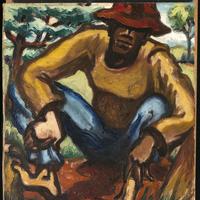More about Claude Clark
Works by Claude Clark

Contributor
Claude Clark took a palette knife to the art world, mixing education and social activism into his paint and ink.
Born in Georgia where his father worked in the fields as a tenant farmer, his family moved north to Pennsylvania when he was only seven. There, Clark spent a lot of his time in school learning about art. He studied at the Pennsylvania Museum School of Industrial Art before receiving a grant for research at the Barnes Foundation in 1939. According to Clark himself, he spent those two years studying the works of Renoir, which the foundation had a rich collection of. Then, after helping develop an arts education department at Talladega College in Alabama, he moved with his wife to California where he continued studying. Clark first received a degree from Sacramento State College and then a masters from UC Berkeley in 1962. Nearly twenty years of formal academic study, no big deal.
Clark settled in Oakland where he not only taught at Merritt College (now a part of the Peralta Community College District in the East bay) but helped develop the Oakland art scene. Clark never rested, apparently. During the civil rights era, the Black Panthers asked him to write curriculum which he called A Black Perspective: A Black Teacher’s Guide to a Black Visual Art Curriculum.
His painting style was unique in that he used the palette knife rather than a paintbrush, imbuing many of his works with a sharply impressionistic style that is immediately recognizable, along with his keen eye for social realism. His focus was always the African-American experience, even early in his career when the art world was still infected by a culture of segregation.
Claude Clark was part of the Great Migration and a product of the Harlem Renaissance. Like any renaissance figure, he left quite the legacy behind him.
Sources
- Clark, Claude. "Resting." Smithsonian American Art Museum. Accessed February 2019. https://americanart.si.edu/artwork/resting-4898.
- Driskell, David C., Camille O. Cosby, Bill Cosby, and René Hanks. The Other Side of Color: African American Art in the Collection of Camille O. and William H. Cosby, Jr. San Francisco: Pomegranate, 2001.
- Booker, Robert. "Empowerment - with Moderator and Host Robert Booker." YouTube. December 25, 2014. Accessed February 2019. https://www.youtube.com/watch?v=WmZgnV_qcYg.
Featured Content
Here is what Wikipedia says about Claude Clark
Claude Clark (November 11, 1915 – April 21, 2001) was an American painter, printmaker and art educator. Clark's subject matter was the diaspora of African American culture, including dance scenes, street urchins, marine life, landscapes, and religious and political satire images executed primarily with a palette knife.
Check out the full Wikipedia article about Claude Clark











